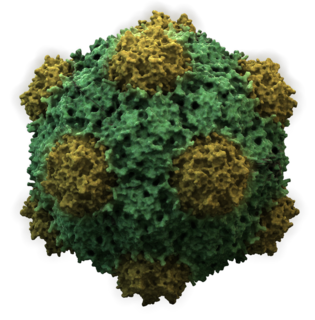
Tobacco mosaic virus (TMV) is a positive-sense single-stranded RNA virus species in the genus Tobamovirus that infects a wide range of plants, especially tobacco and other members of the family Solanaceae. The infection causes characteristic patterns, such as "mosaic"-like mottling and discoloration on the leaves. TMV was the first virus to be discovered. Although it was known from the late 19th century that a non-bacterial infectious disease was damaging tobacco crops, it was not until 1930 that the infectious agent was determined to be a virus. It is the first pathogen identified as a virus.
A satellite is a subviral agent that depends on the coinfection of a host cell with a helper virus for its replication. Satellites can be divided into two major classes: satellite viruses and satellite nucleic acids. Satellite viruses, which are most commonly associated with plants, but are also found in mammals, arthropods, and bacteria, encode structural proteins to enclose their genetic material, which are therefore distinct from the structural proteins of their helper viruses. Satellite nucleic acids, in contrast, do not encode their own structural proteins, but instead are encapsulated by proteins encoded by their helper viruses. The genomes of satellites range upward from 359 nucleotides in length for satellite tobacco ringspot virus RNA (STobRV).
Caulimoviridae is a family of viruses infecting plants. There are currently 85 species in this family, divided among 10 genera. Viruses belonging to the family Caulimoviridae are termed double-stranded DNA (dsDNA) reverse-transcribing viruses i.e. viruses that contain a reverse transcription stage in their replication cycle. This family contains all plant viruses with a dsDNA genome that have a reverse transcribing phase in their lifecycle.

Bromoviridae is a family of viruses. Plants serve as natural hosts. There are currently 36 species in this family, divided among 6 genera.

Comovirinae is a subfamily of viruses in the order Picornavirales, in the family Secoviridae; its genera were formerly classified in the family Comoviridae. Plants serve as natural hosts. There are currently 62 species in this subfamily, divided among 3 genera.

968 Petunia, is a stony asteroid of the Itha family, approximately 28 kilometers in diameter, located in the outer region of the asteroid belt. It was discovered on 24 November 1921, by astronomer Karl Reinmuth at the Heidelberg Observatory in southern Germany. The bright S-type asteroid has a long rotation period of 61.3 hours. It was named after the genus of flowering plants, Petunia.

Potyvirus is a genus of viruses in the family Potyviridae. Plants serve as natural hosts. There are currently 183 species in this genus including the type species Potato virus Y. The genus is named after the type virus. Potyviruses account for ~30% of the currently known plant viruses. Like begomoviruses, members of this genus may cause significant losses in agricultural, pastoral, horticultural and ornamental crops. More than 200 species of aphids spread potyviruses and most are from the subfamily Aphidinae.
Tombusvirus is a genus of viruses, in the family Tombusviridae. Plants serve as natural hosts. There are currently 17 species in this genus including the type species Tomato bushy stunt virus. Symptoms associated with this genus include mosaic. The name of the genus comes from the type species: Tomato bushy stunt virus.

Ruellia humilis is a species of flowering plant in the family Acanthaceae. It is native to the eastern United States. It is grown as an ornamental plant.
Asparagus virus 1 (AV-1) is one of the nine known viruses that affects asparagus plants. It is in the Potyviridae family. Initially reported by G. L Hein in 1960, it is a member of the genus Potyvirus and causes no distinct symptoms in asparagus plants. The only known plant that can get AV-1 is asparagus plants. It is spread by aphids vectors, which means that aphids do not cause the AV-1, but they do spread it.

Cucumber mosaic virus (CMV) is a plant pathogenic virus in the family Bromoviridae. It is the type member of the plant virus genus, Cucumovirus. This virus has a worldwide distribution and a very wide host range. In fact it has the reputation of having the widest host range of any known plant virus. It can be transmitted from plant to plant both mechanically by sap and by aphids in a stylet-borne fashion. It can also be transmitted in seeds and by the parasitic weeds, Cuscuta sp. (dodder).

Tomato mosaic virus (ToMV) is a plant pathogenic virus. It is found worldwide and affects tomatoes and many other plants.

Betaflexiviridae is a family of viruses in the order Tymovirales. Plants and fungi serve as natural hosts. There are currently 108 species in this family, divided among 13 genera in two subfamilies. Diseases associated with this family include: mosaic and ringspot symptoms.

Secoviridae is a family of viruses in the order Picornavirales. Plants serve as natural hosts. There are currently 86 species in this family, divided among 8 genera or not assigned to a genus. The family was created in 2009 with the grouping of families Sequiviridae, now dissolved, and Comoviridae, now subfamily Comovirinae, along with the then unassigned genera Cheravirus, Sadwavirus, and Torradovirus.

Emaravirus is a genus of plant viruses and the sole genus in the family Fimoviridae. The genus has 11 species. The type species European mountain ash ringspot-associated emaravirus is associated with a leaf mottling and ringspot disease of European mountain ash Sorbus aucuparia. It can be transmitted by grafting and possibly mites.
Marafivirus is a genus of viruses in the order Tymovirales, in the family Tymoviridae. Plants serve as natural hosts. There are currently ten species in this genus including the type species Maize rayado fino virus.

Tymovirus is a genus of viruses in the order Tymovirales, in the family Tymoviridae. Plants serve as natural hosts. There are currently 28 species in this genus including the type species Turnip yellow mosaic virus.

Nicola Spence is the Chief Plant Health Officer and Deputy Director for plant and bee health at the Department for Environment, Food and Rural Affairs.
Clerodendrum golden mosaic China virus (ClGMCNV) is a bipartite Begomovirus isolated from flowering plants in the Clerodendrum genus. The virus causes yellow mosaic disease in various plant species, including Nicotiana, Petunia, Solanum, and Capsicum species. It is associated with a mosaic disease known as 'Dancing Flame'.











